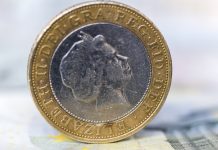Brexit and global growth fears drove movement in the pound US dollar exchange rate on Tuesday. The pair dropped to a low of US$1.3031 paring some losses. The pair closed the
session on Tuesday at US$1.3054. The pound US dollar exchange rate was steady ahead of Super Wednesday, a day packed with UK and US risk events.
| What do these figures mean? |
|---|
| When measuring the value of a pair of currencies, one set equals 1 unit and the other shows the current equivalent. As the market moves, the amount will vary from minute to minute.For example, it could be written:1 GBP = 1.28934 USDHere, £1 is equivalent to approximately $1.29. This specifically measures the pound’s worth against the dollar. If the US dollar amount increases in this pairing, it’s positive for the pound. Or, if you were looking at it the other way around:1 USD = 0.77786 GBPIn this example, $1 is equivalent to approximately £0.78. This measures the US dollar’s worth versus the British pound. If the sterling number gets larger, it’s good news for the dollar. |
With just a few days to go until the UK is due to leave the European Union Brexit nerves were showing through. UK Prime Minister Theresa May’s talks with French President Macron and Germany’s Angela Merkel appeared to be in vain. Brussels have been vocal in their preference for a long Brexit extension. On Tuesday Donald Tusk reaffirmed this preference saying that he did not believe that Theresa May could break the Brexit deadlock in Westminster before 30th June.
The pound is not taking the possibility of a longer extension well. This would mean the UK taking part in EU elections, which could prove to be toxic for Theresa May.
Prior to the EU Brexit Summit pound traders will digest a slew of UK data including industrial production and GDP readings. Analysts are predicting that economic growth in Britain was a lacklustre 0.2% in the three months to February. On a monthly basis, economic growth is expected to have stalled altogether. A weak print could add pressure onto the pound.
| Why does poor economic data drag on a country’s currency? |
|---|
| Slowing economic indicators point to a slowing economy. Weak economies have weaker currencies because institutions look to reduce investments in countries where growth prospects are low and then transfer money to countries with higher growth prospects. These institutions sell out of their investment and the local currency, thus increasing supply of the currency and pushing down the money’s worth. So, when a country or region has poor economic news, the value of the currency tends to fall. |
Fed Minutes & US Inflation In Focus
The dollar was broadly stronger in the previous session. Investors looked towards the safe haven properties of the dollar as fears for the health of the global economy ramped up. The International Monetary Fund (IMF) downgraded global growth for the third time in six months.
Today is set to be a busy day for the dollar as investors digest inflation data in addition to the minutes from the Federal Reserve’s monetary policy meeting.
The minutes are from the March meeting, where the Fed announced an early end to its balance sheet reduction programme and increased its warnings over the state of the global economy. Given that the minutes come a few weeks after the meeting, some economists consider them to be outdated. However, the minutes do add more colour to the known rhetoric, and so could fresh out what has already been said.
Analysts broadly expect the Fed to have echoed the message of a strong domestic economy against a weaker global economy. They could also mention the strength of the US job market. Depending on where the Fed put the emphasis, the dollar could respond accordingly. A strong focus on the robust domestic economy could boost the dollar. Any comments from policy makers about cutting interest rates could hit demand for the dollar hard.
| Why do raised interest rates boost a currency’s value? |
|---|
| Interest rates are key to understanding exchange rate movements. Those who have large sums of money to invest want the highest return on their investments. Higher interest rate environments tend to offer higher yields. So, if the interest rate or at least the interest rate expectation of a country is relatively higher compared to another, then it attracts more foreign capital investment. Large corporations and investors need local currency to invest. More local currency used then boosts the demand of that currency, pushing the value higher. |
This publication is provided for general information purposes only and is not intended to cover every aspect of the topics with which it deals. It is not intended to amount to advice on which you should rely. You must obtain professional or specialist advice before taking, or refraining from, any action on the basis of the content in this publication. The information in this publication does not constitute legal, tax or other professional advice from TransferWise Inc., Currency Live or its affiliates. Prior results do not guarantee a similar outcome. We make no representations, warranties or guarantees, whether express or implied, that the content in the publication is accurate, complete or up to date. Consult our risk warning page for more details.
This article was initially published on TransferWise.com from the same author. The content at Currency Live is the sole opinion of the authors and in no way reflects the views of TransferWise Inc.





